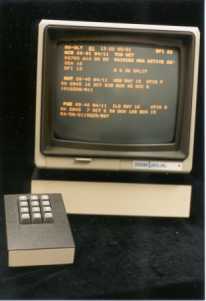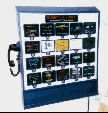



|

|

|
Introducing Strobe Data Inc.
Located in Washington State's Puget Sound high tech corridor not far from Microsoft headquarters, Strobe Data Inc is a 30 year-old company which designs and manufactures PC add-in boards sold internationally as replacements 16 bit minicomputers: the Osprey Co-Processor, targeted to Digital Equipment Corporation's PDP-11; the Kestrel, replacing HP1000 computers; and the Hawk, a Data General Nova/Eclipse replacement. Strobe Data also offers a general purpose USB compatible multiplexer for Windows driven PCs.
Willard and Vera West founded Strobe Data in 1974 to provide computerized process control systems to the wood products industry. Strobe's pioneering integration of 8080 processors with Data General minicomputers established the company's reputation for innovative computer system design. As a Data General OEM Strobe found itself slipping into third party field service operations with an expanded customer base including The Boeing Company, and Rocket Research (Olin), as well as health care institutions, universities, banks, the US Navy and other government agencies. Its days as a field service provider instituted a legacy of strong customer support. Its last remaining service contract (a weather display monitor) was terminated by Alaska airlines in 1999! In 1998, a frantic call sent Strobe engineers to a Weyerhaeuser mill site in Oregon to repair a 25-year-old Strobe log analyzer. In December, 2000, an Australian VAR called to say he was sending a tired 13-year-old Strobe board in from the Outback for repair and announced his son would interrupt his once-in-a-lifetime world tour to pick it up and carry it back to Melbourne. Strobe promised to fix it.
In 1978 Strobe Data began the development of a multi-station weather and information display system for the Northwest Regional offices of the FAA. By 1980 the system was so successful the company was encouraged to develop a display network to advertise long-haul jobs for trucking companies at major truck stops on the West Coast. By 1986 this network had expanded to over 300 installations, nationwide. Adaptations of this design produced an innovative call-board for the truck stops and a reader board for Washington Mutual Savings Bank.
By the mid-80's Strobe Data realized that the future of mass computing truly lay with microcomputer technology. Refusing to forsake its minicomputer past, Strobe concentrated on merging the two technologies. The company produced automatic program loading devices and specialized diskette controllers out of 8- and 16-bit Intel processors. At the same time a multibus-compatible single board computer, based on the Fairchild F9445 processor, was designed and built for Meteor Communications Inc. The application replaced interception prone medium range satellite communications with a secure system based on ionization trails left by micro-meteorites in the stratosphere.
From merging micro with mini technology, the company moved its attention to replacing traditional 16-bit minicomputers with micro-based computer components. The Strobe engineers envisioned a way to move a minicomputer application, lock, stock and operating system, to an ordinary PC with no change of any kind being made to the software. Development on the Falcon Co-Processor, a Data General Nova computer on a PC add-in board, began late in 1985. Hazeltine Corp got wind of the effort and on Nov 30, 1987, Micro-Ticcit, a computer aided instruction system based on the Falcon, was formally announced in a government products show near Washington, DC. Demonstrations were provided by Hazeltine and three of its customers, including British Airways.
By fourth quarter 1987, small numbers of Falcon Co-Processors were in the hands of over 25 OEM customers. A distribution arrangement had been signed for Australia/New Zealand/ Singapore. Another agreement signed for England/Common Market, and a West German customer was test marketing the product for distribution in Southern Germany. Within a year, boards had been delivered in Canada, Israel, England, Switzerland, Puerto Rico, Argentina, Australia, New Zealand, Germany, Belgium, and Italy, and to most areas of the US. ICL of the UK became a major customer, along with GE, and Ford Aerospace (Loral Electronics). The US Navy and Los Alamos National Labs joined the Falcon club.
Plans to extend the Falcon concept bore fruit early in 1990 with the release of the Hawk -- a 280 nanosecond replacement for DG's 16-bit Eclipse computers. A direct bus communi-cation option was added for the automated test and telecommunications industries, longtime users of Data General 16 bit technology. The company's customer base expanded to include Honeywell, Texas Instruments, IBM, GE, and EDS (Electronic Data Systems), Shell Oil, Conoco, as well as LTX Corp, Schlumberger, and Data General, itself.
The Hawk development had run piggy-back on a desperate collaboration with near-by IC Designs (since merged with Cypress Technology) to second source the F9445 processor when National Semiconductor through its acquisition of Fairchild Semiconductor in 1988, discontinued production of the chip, essentially the central processing unit of the Falcon. This effort extended company expertise into IC level design. As a part of this development, the company not only released its own version of the F9445 (the ICD9445), but used it to produce a limited memory, faster version of the Falcon. The company called it the Swift.
Enhancements to the Falcon/Swift/Hawk environment -- a 16/32 port PC multiplexer, terminal emulation to replace minicomputer serial line communications with PC networks, and a Windows compatibility mode -- thrust the company more deeply into PC technology. The design of a rack mountable chassis tailored to Hawk/PC systems with accommodation for up to five 15" Data General Nova/Eclipse controller boards led to a contract to replace 164 S130 Eclipse computers in the National Weather Service nation-wide weather analysis/distribution system.
Flush with its Nova/Eclipse replacement success, Strobe tackled Digital Equipment Corporation's PDP-11. Development on the Osprey Co-Processor began in 1993. By June 1994, an Osprey was running RSTS applications for the US Navy. The Qbus and Unibus adapter cards were added to round out the Osprey product line for shipment to companies in the ATE and process control industries and the Canadian Government. More special chassis followed and a program to emulate all the common PDP-11 compatible devices was enthusiastically embraced.
The Osprey was initially designed around the DCJ11/FPJ11, the basic chip set of the PDP-11 CPU. In 1996, Digital announced the end of the PDP-11 line and threatened to pull the plug on Strobe's source of DCJ11 chips. In the same way the Fairchild acquisition by National Semiconductor had put Strobe on an all-out design effort leading to the Hawk, DEC's end-of-life announcement for the DCJ11 chips forced a new design for the Osprey. The result was a sophisticated multi-processor implementation of the PDP-11 architecture yielding significantly greater throughput and more flexibility than the earlier design. This design flexibility made it possible to morph the ISA-compatible Osprey into a high performance PCI version. Fibre-channel interface with real I/O pushed throughput even higher.
Where the Hawk had become an integral part of a major ATE manufacturer's product line, the Osprey soon followed into the fabs and clean rooms of Intel and other major chip manufacturers. ATE was not neglected. Users of Genrad and Minato test equipment upgraded with high speed Osprey processing. The Osprey entered the world of high finance when Reuters subsidiary, Instinet, acquired a number to speed up after-hours trading on the stock market. Even the US Postal service upgraded its operations with Ospreys.
With the success of the Osprey assured in an eclectic international market that includes Siemens and Pirelli, Strobe cast its eye in the direction of Hewlett Packard and the venerable HP1000, long a standard architecture for scientific and embedded computing. In 1999, as the world prepared for the coming of the new millennium, Strobe began the next chapter in its legacy system story.
The Kestrel in its initial form as the Kestrel/900, a re-architected A-Series HP1000 CPU with better performance than an A900, was beta-tested in February, 2001. Commercial release of lower performance models, the Kestrel/600+, the Kestrel/700, and Kestrel/400 followed by the end of the year. An M/E/F-series replacement, Kestrel/MEF CPU was ready in 2002. By then, a chassis for the A-Series had made its appearance. Device emulations for the A-Series, including a CS80 disk and HPIB interface became available in the first quarter of 2003, along with device emulations and a chassis for the MEF. The emulation list for both Kestrel lines continues to grow.
And then what? Suggestions come pouring in and Strobe designers keep plugging away. A “blazing fast” version of the PDP-11 architecture should be available sometime in 2003. Meantime, preliminary investigations into the technical and marketing problems posed by both the HP3000 family and the VAX computer family are taking place. Emulations for both computers appear eminently do-able, given the well-developed in-house expertise.
 FAA Terminal |
 Trucking Industry Call Board |
 Forest Product Industry |
 Radar Range Finder |
|
|
|